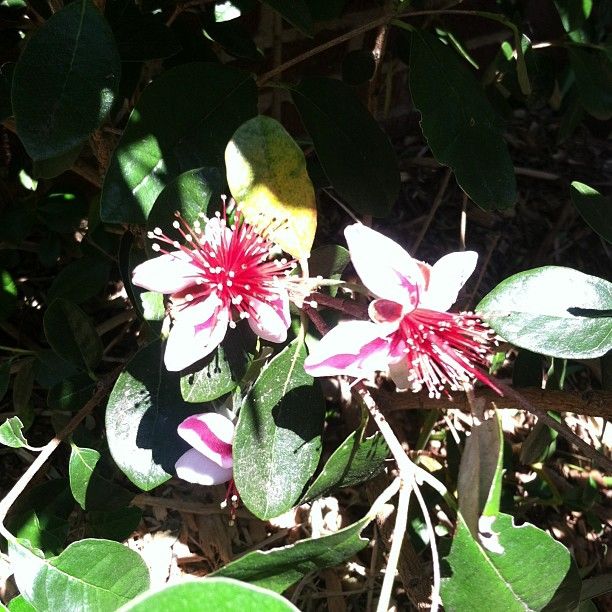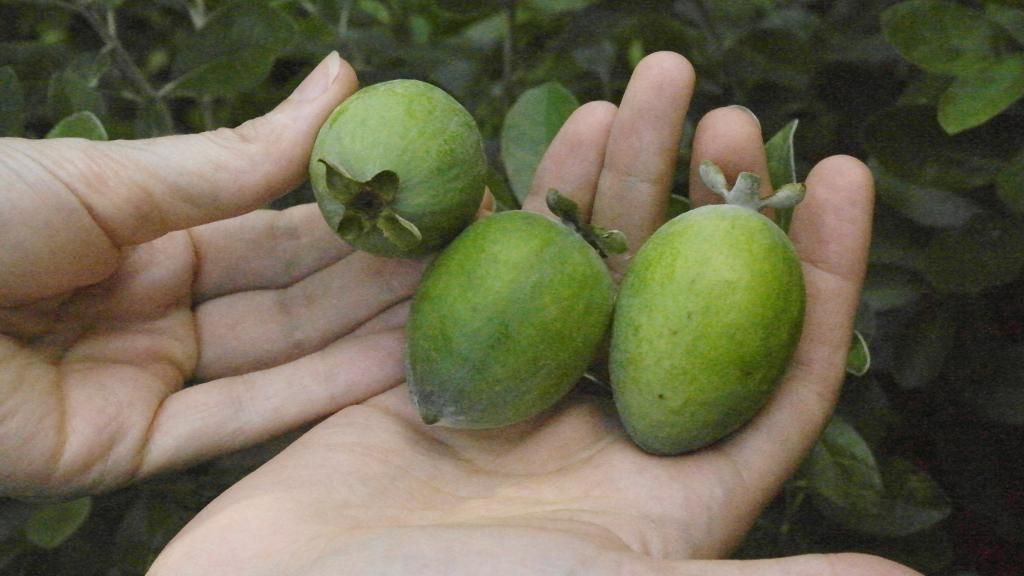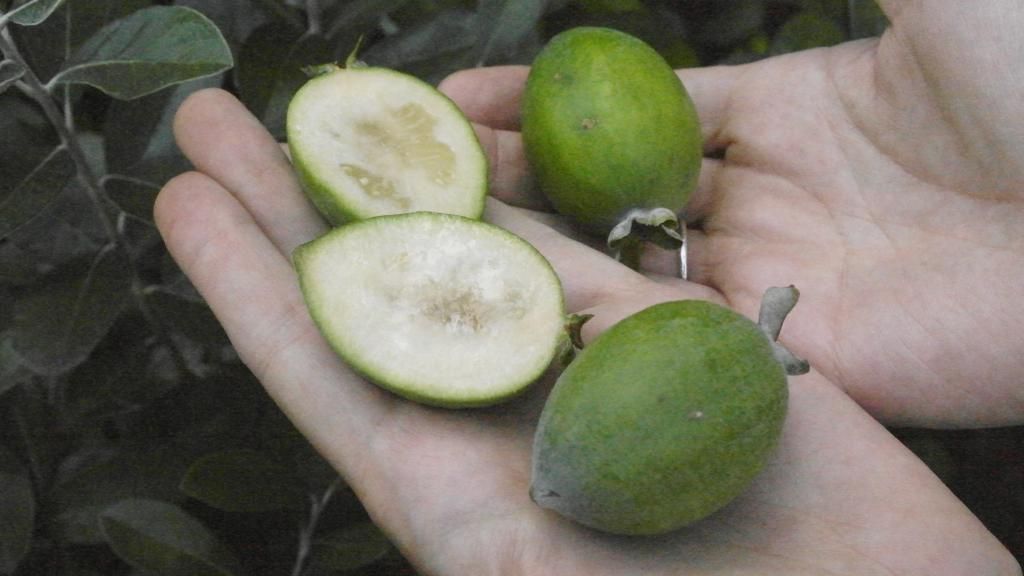How to Grow and Harvest Feijoa
One thing that I have really come to love about living in upstate South Carolina is the sheer diversity of fruits and vegetables that we can grow. Having come from Vermont, where the short summers and extremely cold winters put a major limit on what can be grown each year, South Carolina has struck me as an Eden of sorts. Previously, I always had to eat most of my fresh produce as shipped items (especially peaches), but now I get to try my hand at growing familiar food as well as some plants I had never even heard of. Really, it amazes me to live in a place where I can grow my own pomegranates and figs. With a bit of work, I can even pick my own fresh citrus. It’s great!

Feijoa (aka Pineapple Guava) are attractive evergreen shrubs or small trees. They make excellent urban permaculture foundation plantings due to their usefulness and curb appeal.
One of the stranger fruits that we have decided to give a shot to is feijoa (Acca sellowiana), which is also commonly called pineapple guava. (I am refraining from calling it that myself, because it is neither a pineapple nor a guava). Feijoas are a member of the Myrtaceae family, which includes such notables as eucalyptus, clove, allspice, and true guavas. The plant is an evergreen shrub or small tree, generally not growing taller than ten feet in height (though it can be pruned to keep it shorter than that), with attractive foliage and colorful flowers. Originating in South America, feijoas were first brought to the United States in the late 19th to early 20th century. At first they were grown as ornamentals rather than food plants (while in New Zealand and Australia they became popular for their fruit). It was not until some time later that the fruit began to become a desired aspect of growing feijoas.
While feijoas can grow pretty well in our zone 8 region of South Carolina, they do need to be looked after the first couples of years. They are reported to be sensitive to cold winds and so are best planted up against a wall or some other structure that can give them a bit of shelter. Once they have been established, they should have no problem handling the South Carolina winters. Only up in the mountains might they succumb to cold (temperatures continually below 16° F will probably kill them). Feijoa actually need at least 50 cold hours each winter to set blossoms, so a bit of chill is not a bad thing. Our two plants are positioned along a narrow brick wall in our front yard. This provides them with the shelter from the wind. Additionally, the afternoon sun heats the wall and creates a microclimate that benefits the feijoas when the weather turns cooler.
The feijoas put out buds in spring which open into flowers sometime in May and June. The flower petals are a very attractive pink and white (personally I find them somewhat similar in shape to fuchsia flowers, though larger, and more flamboyant). The fleshy petals are edible and can be removed for eating without destroying the flower as a whole (so that they still fruit). They give off a pleasant scent, sweet and almost spicy (which is a reminder of its relation to things like clove and allspice). The flavor of the petals is mild and fruity, again with the slightest hint of spice.

The flowers of the feijoa open in late May or early June. They are stunning gems that cover the plant and give off a very pleasant fragrance.
Feijoas are most likely to bear fruit if you have two plants growing in very close proximity with each other (its okay for them to be close enough to touch each other). While they can fruit without another plant, pollination will be significantly lower. We were lucky this year to get any fruit as only one of our two plants flowered (of the two it was the older plant, we’re hoping that the other one has grown enough that it will flower next year). If pollination is successful, the fruits will begin to develop in June and will grow throughout the summer months. The fruits are about the size of a chicken egg, ovoid in shape, and have a fairly tough green leathery skin. They come to ripeness in autumn (October here in SC) and will fall from the plant when they are ready to eat.

The fruits of the feijoa are about the size of a chicken egg, with a leathery green skin. When they are ripe and ready to eat in the autumn they will fall to the ground. If you grow some, remember to check for mature fruit beneath the plant.
The easiest way to eat a feijoa is to cut it in half or quarters and scoop out the pale flesh and seed pulp with a spoon (or your teeth). While the skin isn’t poisonous, it’s very bitter and not recommended for consumption. The flesh and seeds of the feijoa are an amazing flavor blast that is hard to define in terms of other flavors. “Tropical” is the immediate word that came to my mind, but it begged comparison to several other things: a bit of citrus, a little pineapple, maybe some star fruit, and definitely a similarity to true guavas — but in the end it is something all its own. They taste like feijoas and they are wonderfully delicious. I felt a great deal of disappointment that we only got four fruits this year, and am eagerly hopeful that next year both plants will flower and produce more of a crop.

The flesh inside the fruit is pale and grainy and surrounds pulpy, jelly-like seeds. The cut fruit gives off a rich and delicious aroma.
Quick searches online and in a few of our books turned up all sorts of suggested uses for feijoa fruit. The strong flavor would go well simply in a fruit salad, blended into a smoothy, paired with yogurt, or made into an ice cream. They are reported to make good jams and preserves, to act as more flavorful substitutes in recipes that call for bananas, and to impart an interesting and exotic quality to chutneys (something I’m eagerly anticipating because I love cooking a good chut). For a helpful source of ideas and a lot of recipes I recommend checking out the Feijoa Feijoa blog (which, as the name may suggest, is an entire blog devoted to feijoas).

There are many possible uses for the feijoa fruit: breads, preserves, ice cream, etc. Having only four fruits this year, we decided to keep it simple and serve them with some star fruit (which share a similarity in flavor).
So, here’s to the feijoa! A fantastical and fascinating fruit. Something exotic that can provide your garden or yard with a “wow” factor, which I had never heard of prior to coming to South Carolina.
Enjoy!
~Nathaniel
Available for purchase from Logees or Ison’s nursery.
2 thoughts on “How to Grow and Harvest Feijoa”
Comments are closed.

Mark Willis
Twitter: marksvegplot
- October 12, 2013 3:39 am
I have previously seen (and photographed!) this plant in the south of France, but at the time it only had flowers, and no fruits, so I’m glad you have shown me what they are like. It sounds as if eating them is a bit like eating a Passionfruit – in that you scoop out the inside and discard the skin. Let’s hope you get a bigger harvest next year.
Mark Willis´s last blog post ..Climbing bean “Veitch’s”
Eliza Lord
Twitter: appalachianfeet
- October 12, 2013 9:29 am
I didn’t realize that they grow them in France as well. They are quite a nice plant for both their ornamental and food properties. I’m definitely eager to see if we get a larger harvest next year. Thanks for the comment.